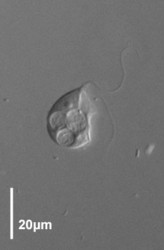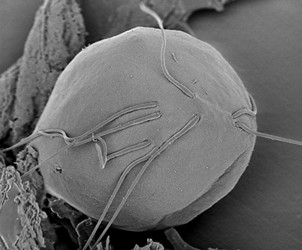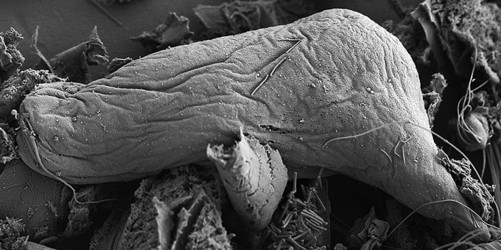Preaxostyla
Patrick Keeling, Kevin Carpenter, Vladimir Hampl, and Alastair Simpson


This tree diagram shows the relationships between several groups of organisms.
The root of the current tree connects the organisms featured in this tree to their containing group and the rest of the Tree of Life. The basal branching point in the tree represents the ancestor of the other groups in the tree. This ancestor diversified over time into several descendent subgroups, which are represented as internal nodes and terminal taxa to the right.

You can click on the root to travel down the Tree of Life all the way to the root of all Life, and you can click on the names of descendent subgroups to travel up the Tree of Life all the way to individual species.
For more information on ToL tree formatting, please see Interpreting the Tree or Classification. To learn more about phylogenetic trees, please visit our Phylogenetic Biology pages.
close boxIntroduction
Preaxostyla is a group of anaerobic/microaerophilic protozoa, uniting two subgroups: the oxymonads, which are commensals or symbionts of animals, and the free-living taxon Trimastix.Characteristics
The identifying morphological synapomorphy for the group is the ‘preaxostylar’ structure of the non-microtubular “I” fibre - the I fibre of Trimastix is homologous to the non-microtubular portion of the oxymonad axostyle, and similar in cross-sectional appearance (see Simpson, 2003).
Preaxostyla is one of several groups within Excavata characterized by a lack of classical mitochondria.
Discussion of Phylogenetic Relationships
The taxon Preaxostyla was established to recognize the well-supported relationship of Trimastix and oxymonads in molecular phylogenetic analyses (Simpson, 2003). Prior to the use of molecular data, both Trimastix and oxymonads were hypothesized to be related to a variety of other eukaryotes, but none with much certainty (see Dacks et al., 2001 for discussion). SSU rRNA gene phylogenies including Trimastix and the oxymonad Pyrsonympha showed the first strongly supported position for either lineage, as sisters to one another (Dacks et al., 2001). This has been further supported by other single- and multi-gene phylogenies (Hampl et al., 2005; Hampl et al., 2009; Slamovits and Keeling, 2006).The relationship of Preaxostyla to other eukaryotes remains less certain. They were proposed to be members of the Excavata based on the typical excavate structure of the cytoskeleton of Trimastix (O’Kelly et al., 1999; Simpson et al., 2000), remnants of which were subsequently identified in the oxymonad Monoceromonoides (Simpson and Patterson, 2001; Simpson et al., 2002), Recent multi-gene molecular phylogenies have supported the monophyly of most, and probably all, Excavata, including Preaxostya (Hampl et al., 2009). The weight of molecular phylogenetic evidence suggests that Preaxostyla is most closely related to parabasalids and Fornicata, the other major groups of Excavata that lack classical mitochondria (Cavalier-Smith, 2003; Simpson et al., 2008; Hampl et al., 2009), however a closer relationship with Malawimonas remains plausible (see Simpson et al., 2006).
References
Cavalier-Smith, T. (2003) The excavate protozoan phyla Metamonada Grasse emend. (Anaeromonadea, Parabasalia, Carpediemonas, Eopharyngia) and Loukozoa emend. (Jakobea, Malawimonas): their evolutionary affinities and new higher taxa. Int. J. Syst. Evol. Microbiol. 53: 1741-1758.
Dacks, J.B., Silberman, J.D., Simpson, A.G.B., Moriya, S., Kudo, T., Ohkuma, M. and Redfield, R.J. (2001) Oxymonads are closely related to the excavate taxon Trimastix. Mol Biol Evol, 18, 1034-1044.
Hampl, V., Horner, D.S., Dyal, P., Kulda, J., Flegr, J., Foster, P.G. and Embley, T.M. (2005) Inference of the phylogenetic position of oxymonads based on nine genes: support for Metamonada and Excavata. Mol Biol Evol, 22, 2508-2518.
Hampl, V., Hug, L., Leigh, J.W., Dacks, J.B., Lang, B.F., Simpson, A.G.B. and Roger, A.J. (2009) Phylogenomic analyses support the monophyly of Excavata and resolve relationships among eukaryotic "supergroups". Proc Natl Acad Sci U S A, 106, 3859-3864.
O'Kelly C.J., Farmer M.A. and Nerad T.A. 1999. Ultrastructure of Trimastix pyriformis (Klebs) and similarities of Trimastix species with retortamonads and jakobids. Protist 150, 149-162.
Simpson, A.G.B. (2003) Cytoskeletal organization, phylogenetic affinities and systematics in the contentious taxon Excavata (Eukaryota). Int J Syst Evol Microbiol, 53, 1759-1777.
Simpson, A.G.B., Bernard, C. and Patterson, D.J. (2000) The ultrastructure of Trimastix marina Kent, 1880 (Eukaryota), an excavate flagellate. Europ. J. Protistol. 36, 229-252.
Simpson, A.G.B., Inagaki, Y. and Roger, A.J. (2006) Comprehensive multigene phylogenies of excavate protists reveal the evolutionary positions of "primitive" eukaryotes. Mol Biol Evol, 23, 615-625.
Simpson, A.G.B. and Patterson, D.J. (2001) On core jakobids and excavate taxa: the ultrastructure of Jakoba incarcerata. J Eukaryot Microbiol, 48, 480-492.
Simpson, A.G.B., Perley, T. & Lara, E., (2008) Lateral transfer of the gene for a widely used marker, alpha tubulin, indicated by a multi-protein study of the phylogenetic position of Andalucia (Excavata). Mol. Phylogenet. Evol. 47: 366-377.
Simpson, A.G.B., Radek, R., Dacks, J.B. and O'Kelly, C.J. (2002) How oxymonads lost their groove: an ultrastructural comparison of Monocercomonoides and excavate taxa. J Eukaryot Microbiol, 49, 239-248.
Slamovits, C.H. and Keeling, P.J. (2006) Pyruvate-phosphate dikinase of oxymonads and parabasalia and the evolution of pyrophosphate-dependent glycolysis in anaerobic eukaryotes. Eukaryot Cell, 5, 148-154.
Title Illustrations

| Scientific Name | Trimastix marina |
|---|---|
| Comments | Monoprotistan culture, strain WL |
| Specimen Condition | Live Specimen |
| Identified By | Alastair Simpson |
| Image Use |
 This media file is licensed under the Creative Commons Attribution-NonCommercial License - Version 3.0. This media file is licensed under the Creative Commons Attribution-NonCommercial License - Version 3.0.
|
| Copyright |
© 2009 Alastair Simpson

|
| Scientific Name | Monocercomonoides globus |
|---|---|
| Comments | Monocercomonoides globus (Family Polymastigidae) from the hindgut of the North American wood-roach Cryptocercus punctulatus. Specimen is approximately 15 microns long. |
| Acknowledgements | Patrick Keeling |
| Identified By | Kevin J. Carpenter and Patrick Keeling |
| Image Use |
 This media file is licensed under the Creative Commons Attribution-NonCommercial License - Version 3.0. This media file is licensed under the Creative Commons Attribution-NonCommercial License - Version 3.0.
|
| Copyright |
©
Kevin Carpenter

|
| Scientific Name | Saccinobaculus ambloaxostylus |
|---|---|
| Comments | Saccinobaculus ambloaxostylus (Family Saccinobaculuidae) from the hindgut of the North American wood-roach Cryptocercus punctulatus. Specimen is approximately 80 microns in length. |
| Acknowledgements | Patrick J. Keeling |
| Identified By | Kevin J. Carpenter and Patrick J. Keeling |
| Image Use |
 This media file is licensed under the Creative Commons Attribution-NonCommercial License - Version 3.0. This media file is licensed under the Creative Commons Attribution-NonCommercial License - Version 3.0.
|
| Copyright |
©
Kevin Carpenter

|
About This Page
This page is being developed as part of the Tree of Life Web Project Protist Diversity Workshop, co-sponsored by the Canadian Institute for Advanced Research (CIFAR) program in Integrated Microbial Biodiversity and the Tula Foundation.
Patrick Keeling

The University of British Columbia, Vancouver, British Columbia, Canada
Kevin Carpenter

Lawrence Livermore National Laboratory, Livermore, California, USA
Vladimir Hampl

Dalhousie University, Halifax, Nova Scotia, Canada
Alastair Simpson

Dalhousie University, Halifax, Nova Scotia, Canada
Correspondence regarding this page should be directed to Patrick Keeling at
pkeeling@interchange.ubc.ca
, Kevin Carpenter at
carpenter37@llnl.gov
, Vladimir Hampl at
vladimir.hampl@dal.ca
, and Alastair Simpson at
alastair.simpson@dal.ca
Page copyright © 2009 Patrick Keeling, Kevin Carpenter , Vladimir Hampl , and Alastair Simpson
 Page: Tree of Life
Preaxostyla.
Authored by
Patrick Keeling, Kevin Carpenter, Vladimir Hampl, and Alastair Simpson.
The TEXT of this page is licensed under the
Creative Commons Attribution License - Version 3.0. Note that images and other media
featured on this page are each governed by their own license, and they may or may not be available
for reuse. Click on an image or a media link to access the media data window, which provides the
relevant licensing information. For the general terms and conditions of ToL material reuse and
redistribution, please see the Tree of Life Copyright
Policies.
Page: Tree of Life
Preaxostyla.
Authored by
Patrick Keeling, Kevin Carpenter, Vladimir Hampl, and Alastair Simpson.
The TEXT of this page is licensed under the
Creative Commons Attribution License - Version 3.0. Note that images and other media
featured on this page are each governed by their own license, and they may or may not be available
for reuse. Click on an image or a media link to access the media data window, which provides the
relevant licensing information. For the general terms and conditions of ToL material reuse and
redistribution, please see the Tree of Life Copyright
Policies.
- First online 26 October 2009
- Content changed 26 October 2009
Citing this page:
Keeling, Patrick, Kevin Carpenter, Vladimir Hampl, and Alastair Simpson. 2009. Preaxostyla. Version 26 October 2009 (under construction). http://tolweb.org/Preaxostyla/124889/2009.10.26 in The Tree of Life Web Project, http://tolweb.org/











 Go to quick links
Go to quick search
Go to navigation for this section of the ToL site
Go to detailed links for the ToL site
Go to quick links
Go to quick search
Go to navigation for this section of the ToL site
Go to detailed links for the ToL site